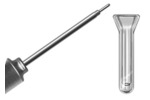Description
... eliminates the accidental venting of the mass spectrometer via the probe inlet
-
Fig. 1 - Probe Sealing Port Mounted on HP 5989 MS
- Complete Probe Inlet includes
- Probe Isolation Valve Assembly
- Probe Sealing Port Assembly with PTFE Seals
- Mass Spec Mounting Bracket
- Probe Guide Bar with Auto-Stop
- Mounts Directly to the HP Probe Inlet Port
- Three Automatic-Quick Release Positions
- Ready or Load Position
- First Vacuum Seal
- Second Seal
- Easy Push-Pin Stop with Quick Release
- Adapts to all manufacturers 1/2" Diameter Probes
This new Probe Inlet System for the H.P. 5988 and 5989 mass spectrometers has been designed to prevent the occasional venting of the mass spectrometer by accidentally pulling the probe past the vacuum seals. The inlet system mounts to the probe inlet port on the H.P. mass spectrometers via the standard 'O' Ring sealing system supplied with the mass spectrometer.
-
The Probe Inlet System consists of -
- The Probe Isolation Valve Assembly & Mount
- The Probe Sealing Port Assembly
- The Guide Bar and Auto-Stop Assembly
The S.I.S. Probe Valve Assembly & Mount comes complete with all seals to permit the delivery of the 1/2" diameter probe rod through the valve and into the mass spectrometer. The assembly mounts directly on the mass spectrometer flange and is sealed via the 'O' ring seal on the mass spectrometer manifold.
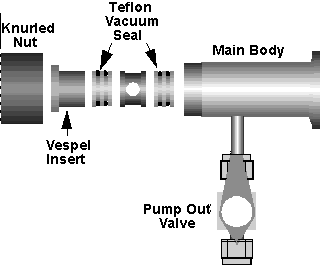
Fig. 2 - Schematic of Probe Sealing Port Assembly
The Probe Sealing Port Assembly includes the redesigned PTFE probe rod seals, pump out valve and a 4' length of Tygon vacuum tubing to connect the valve to the mass spectrometer vacuum pump. It mounts to the Probe Isolation Valve Assembly using an 'O' ring and clamp system. The probe sealing port assembly uses a new PTFE sealing system designed by S.I.S. which provides for much better vacuum sealing of the probe rod as well as longer life. The original vacuum seals on the probe inlet supplied by H.P. are an encapsulated 'O' Ring and two inner spring seals. Our newly designed PTFE seals are far superior. They utilize a large PTFE sealing surface which provides for a cleaner system with longer seal life and superior vacuum sealing.
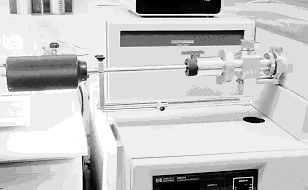
Fig. 3 Entire Probe Port Inlet System and MS Probe Mounted on HP 5989 MS
The Guide Bar and Auto-Stop Assembly is mounted directly onto the Probe Inlet Valve Assembly. Any 1/2" diameter probe can be clamped onto the guide bar assembly. The probe can then be pushed into the vacuum sealing system and valving system with automatic stops at the load position and at the two vacuum seals. This will prevent pushing the probe in too far during initial insertion damaging the probe tip and also prevent inadvertently pulling the probe out too far and venting the mass spec during probe removal. A quick release push button on the probe guide bar releases the probe for travel to the next position. The Probe Inlet System is designed for use with all direct probes, DEP (DCI) probes, FAB probes and other 1/2" diameter probes from S.I.S. and H.P.
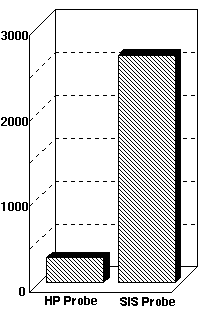
The chart shows the results from a study which was conducted at SIS comparing the HP probe inlet system to the SIS inlet system. The SIS probe inlet system was mounted onto an automatic probe injection system which was fitted to a vacuum chamber where the vacuum was measured with a ionization gauge tube. The vacuum in the chamber was measured after each injection of the probe through the probe inlet. This allowed us to monitor the vacuum levels as the seals in the probe inlet began to wear from repeated use. The probe inlet system was considered to have failed when the ionization gauge would not remain on (i.e. the vacuum was greater than 1 x 1 0-4 torr). As can be seen from the chart the SIS probe inlet system provided satisfactory performance for over 2500 injections of the probe until it failed at injection number 2649. The HP probe inlet was then mounted onto the automatic probe injector and the test repeated. The HP probe inlet first failed at injection number 14. The inlet was removed and inspected. There were fine pieces of graphite throughout the probe inlet. The probe inlet was cleaned, the same exact seals re-inserted and the inlet was remounted to the automatic injector. The test procedure was continued. The probe inlet failed again at injection number 29. The cleaning procedure was done a second time and the test continued. This failure and cleaning process was repeated seven times until the probe inlet failed completely at injection number 290. |
| Part No. | Description | Quantity In Stock |
Price EA |
Order |
|---|---|---|---|---|
| PP300 | HP 5988/5989 Probe Inlet Port with Automatic Stops, Includes Probe Inlet Valve Assembly, Probe Sealing Port Assembly, the Guide Bar and Auto-Stop Assembly. (Probe not included.) | DISCONTINUED | --- | --- |
| PI200 | HP ENGINE PROBE INLET | DISCONTINUED | --- | --- |
| HPP6 | Dummy Probe for use on HP5988/5989 | 0†Standard lead-time for non-stock items is approximately two weeks depending on the item. | CALL | |
| HPP1 | DIP PROBE FOR HP5989 HP EQUIVALENT #05985-60220 | 0‡Lead time for this non-stock item is approximately 5 days. | $4900.00 | |
| HPP2A | DEP/DCI PROBE FOR HP5989 | 0†Standard lead-time for non-stock items is approximately two weeks depending on the item. | $3360.00 | |
|
* Call for availability. † Standard lead-time for non-stock items is approximately two weeks depending on the item. ‡ Lead time for this non-stock item is approximately 5 days. | ||||
|
|
||||
* Call for further information on probes and controllers.
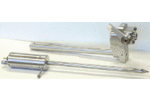 GCQ Probe and Probe Inlet
GCQ Probe and Probe Inlet  Direct Insertion Probe for HP MS with Controller
Direct Insertion Probe for HP MS with Controller  SIS Flared Vials - 10 mm
SIS Flared Vials - 10 mm  High Temperature Direct Probe for HP and Finnigan MS
High Temperature Direct Probe for HP and Finnigan MS  FC-43 (Perfluorotributylamine) Calibration Compound
FC-43 (Perfluorotributylamine) Calibration Compound 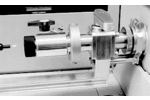 Probe Inlet for HP5989 MS with Automatic Stops
Probe Inlet for HP5989 MS with Automatic Stops  DCI/DEP Probe for HP and Other MS
DCI/DEP Probe for HP and Other MS 


